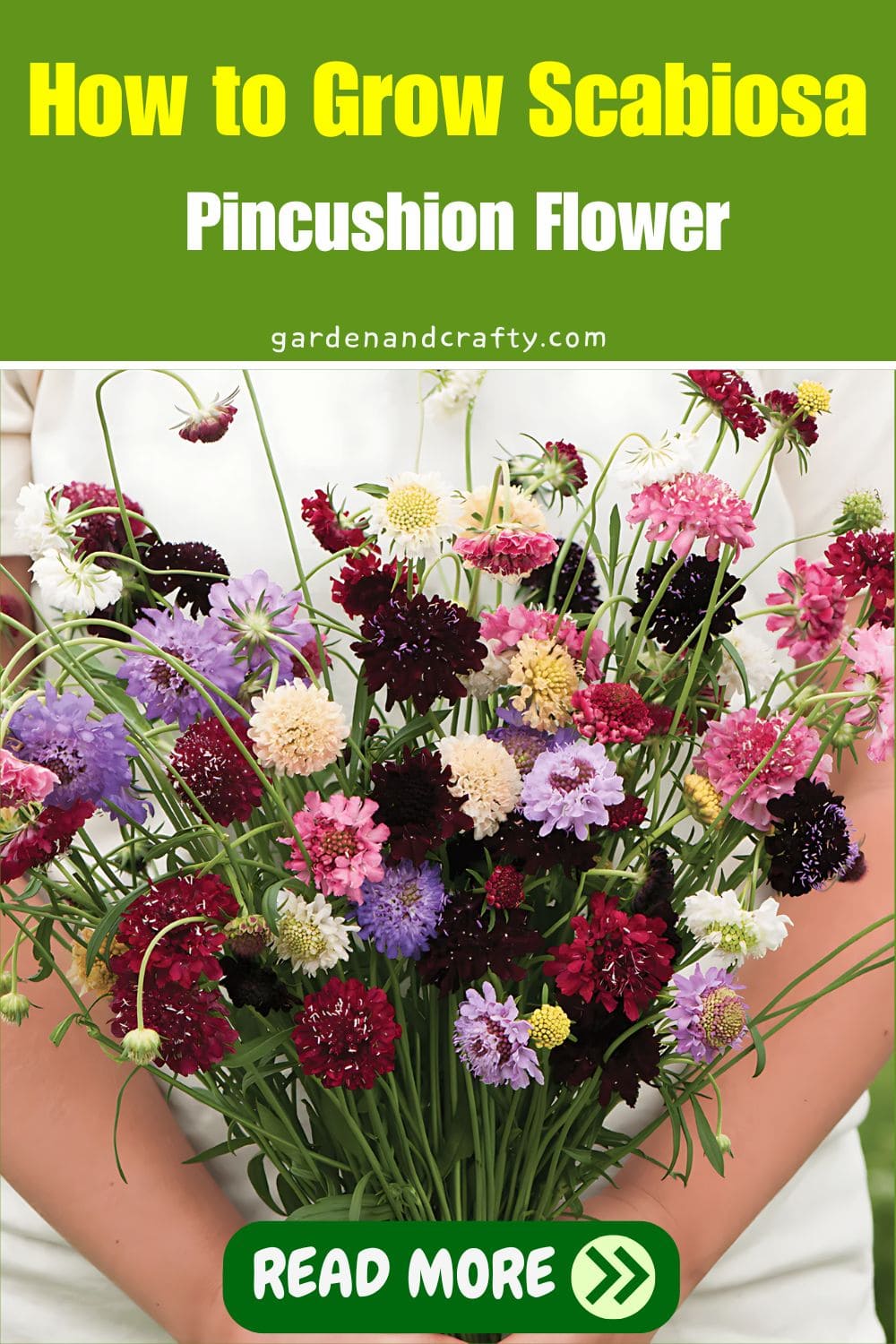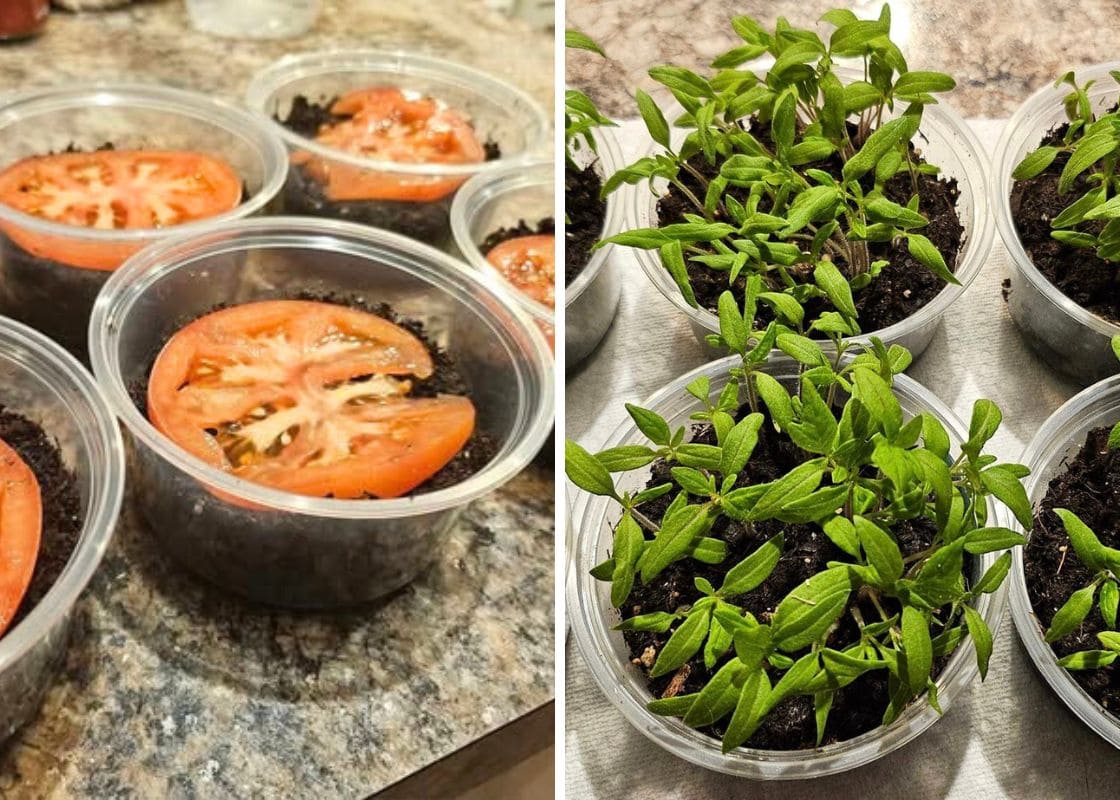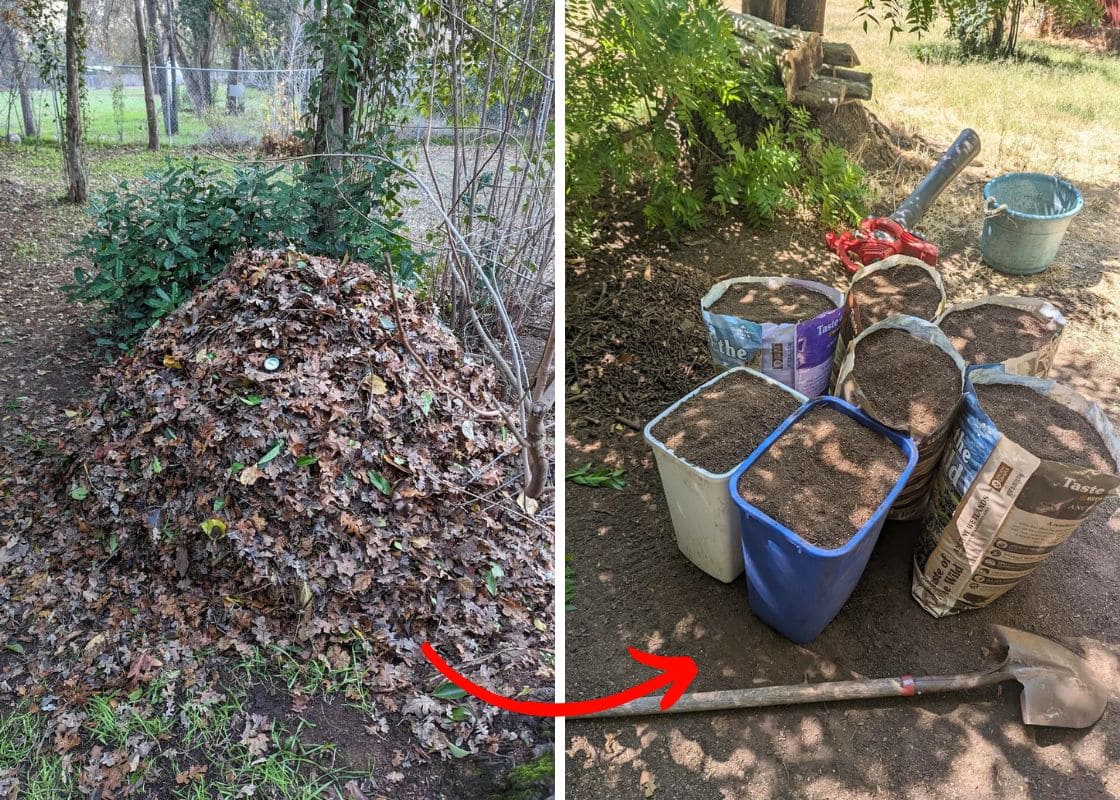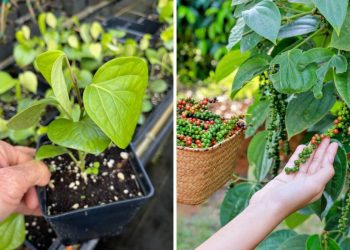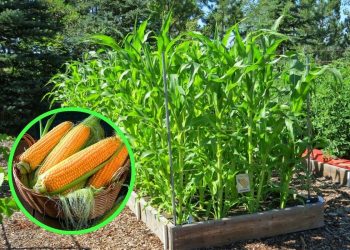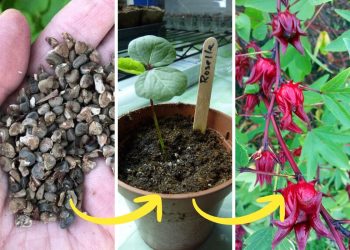Ever wished for a garden flourish with charm? What if delicate blooms sway with the breeze, their colors attracting butterflies and bees?
Scabiosa, or the pincushion flower, offers exactly that and more. With its unique appearance and resilience, it’s a must-have for any garden.
Scabiosa blooms boast intricate, dome-shaped flowers in soft pastels to deep hues attracting pollinators. Beyond their beauty, Scabiosa is easy to grow with minimal care.
Summary:
- Scabiosa owns delicate blooms with lobed leaves.
- You can grow scabiosa successfully by planting in sunny, well-draining soil, and propagate from seeds or cuttings.
- You can use scabiosa to enhance garden borders or as a charming addition to bouquets and floral designs.
| Scientific name | Scabiosa |
| Common names | Pincushion Flower, Scabious |
| Plant type | Herbaceous perennial or annual |
| Height | 30-90 cm |
| Flower color | Blue, pink, purple, white |
| Flower shape | Round, pincushion-like |
| Leaf | Lobed or pinnate |
| Bloom time | Summer to early fall |
| Habitat | Meadows, grasslands, gardens |
| Native range | Europe, Asia, Africa |
Propagation
From Seeds
As noticing flowers bursting with seeds, I gather seeds from these mature flowers.
Back indoors, I start the seeds, create a nurturing environment with a temperature of 70-75°F and ensure the soil remains moist, like a gentle cradle for their delicate roots.
Weeks pass, and I watch with anticipation as tiny seedlings emerge.
As the last frost bids farewell to winter, I take these young plants to the outdoor world. and space them 12-18 inches apart,.
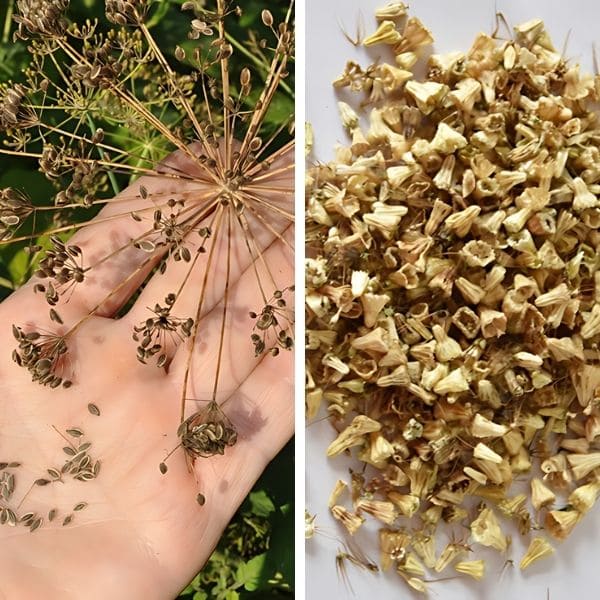
Division
Divide plants in early spring or late summer. Gently separate the root ball into sections with shoots and roots, then replant immediately at the same depth, watering well.
Cuttings
I carefully select strong, non-flowering shoots, about 3-4 inches long. , I remove the lower leaves and gently dip the cuttings in rooting hormone.
Next, I prepare a cozy bed for these cuttings. I keep them sheltered, maintaining warmth to coax roots from their tender stems over the next 4-6 weeks.
Once roots have formed, I carefully transplant them into individual pots or directly into the garden.
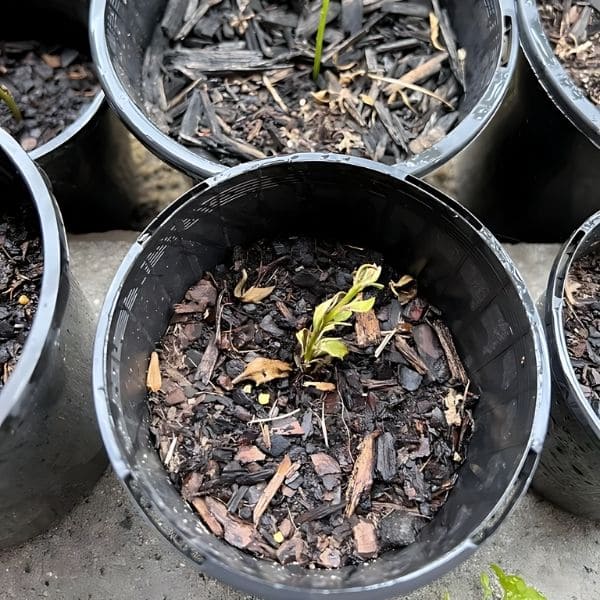
Growing Scabiosa Flowers From Seeds
Preparation
There are four popular types of Scabiosa plants. Here’s a brief overview of each:
- Scabiosa atropurpurea: Features deep purple or burgundy blooms, attracting pollinators and making striking cut flowers.
- Scabiosa caucasica: Known for its large, lavender-blue flowers that bloom profusely in sunny, well-drained locations.
- Scabiosa columbaria: Offers delicate, daisy-like flowers in pale lavender or pink, perfect for rock gardens or borders.
- Scabiosa ‘Butterfly Blue’: Produces masses of lavender-blue flowers resembling butterflies, ideal for containers or small gardens.
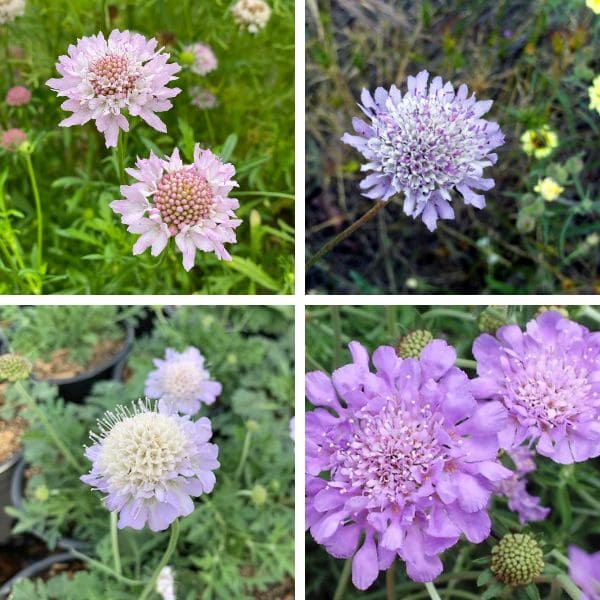
Before planting any scabiosa variety, ensure you choose a sunny spot with well-draining soil.
Enhance soil fertility by incorporating compost or well-rotted manure, and adjust pH levels if necessary with lime to the top 6-8 inches.
Then, soak seeds in 24 hours before planting and consider cold stratification for 2-4 weeks to optimize germination and ensure a thriving garden.
How to Grow Scabiosa Flowers
With the last frost date 8-10 weeks ahead, I begin sowing scabiosa seeds indoors, . I gather seed trays and fill them with a rich, well-draining seed starting mix.
Then I gently press the seeds on the surface of the moist soil mix. I maintain a steady temperature of 70-75°F and remain uncovered under the clear plastic cover.
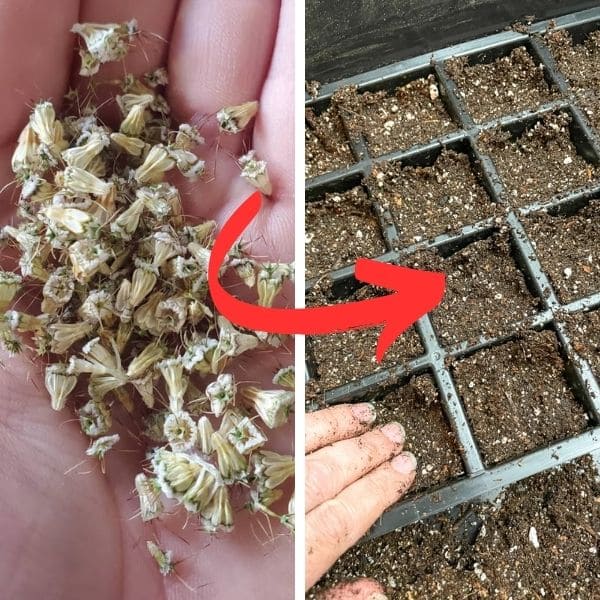
Once tiny green shoots emerge, I begin by acclimating them gradually to outdoors, a few hours each day.
With the threat of frost behind us, I finally transplant these resilient seedlings into the garden, spacing them 12-18 inches apart.
A thin layer of mulch around the base helps retain moisture, while regular watering ensures they thrive, especially during dry spells.
Tips: Plant scabiosa with lavender, yarrow, and echinacea. These plants have similar sunlight and water requirements, creating a visually appealing garden.

Care for Scabiosa
Here are main care requirements for growing Scabiosa flowers:
- Thrives in well-drained, nutrient-rich, loamy soil with a slightly alkaline pH (7.0 to 8.0).
- Requires at least six hours of direct sunlight.
- Keep the soil consistently moist but not waterlogged.
- Apply a balanced, slow-release fertilizer in early spring.
- Deadhead spent flowers and prune plants back by one-third.
Light
Scabiosa requires full sun to partial shade for optimal growth. Ideally, provide at least six hours of direct sunlight daily.
In hotter climates, some afternoon shade is beneficial to prevent scorching. Proper light exposure ensures robust blooming and healthy plant development.
Soil
Scabiosa grows in well-drained, nutrient-rich soil with a slightly alkaline pH (7.0 to 8.0).
Loamy soil, enriched with organic matter like compost or aged manure, is perfect. Good drainage is crucial to prevent root rot, ensuring healthy growth and abundant flowering.
Water
When establishing young Scabiosa flowers, ensure they receive at least an inch of water weekly.
As they mature, they become more drought-tolerant, though their water needs increase significantly during hot summer months.
Mulch
Apply a 2-3 inch layer of organic mulch, such as straw, wood chips, or compost, around the base of Scabiosa plants.
Mulch helps retain soil moisture, suppress weeds, and regulate soil temperature. Ensure the mulch is kept away from the stems to prevent rot and pest issues.
Fertilizer
At early growth, you should apply fertilizer with a 1:1 nitrogen to potassium ratio at 100-150 PPM.
After that, when your scabiosa forms strong roots, you need to increase the nitrogen to potassium ratio to 1:1.5 with 150 PPM nitrogen, 225 PPM potassium and 20-40 PPM phosphorus.
Pruning
Deadheading spent flowers to encourage continuous blooming.
For perennial varieties, make cuts just above a leaf joint or trim stems back to the bottom leaves in fall to maintain a tidy appearance, and encourage new blooms.
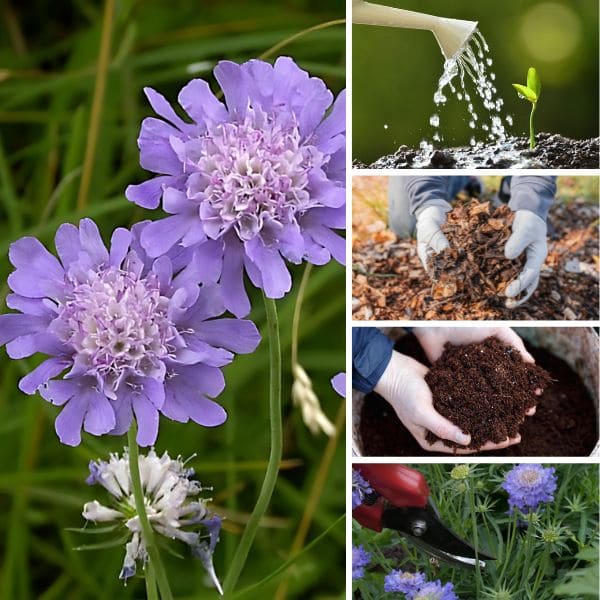
Pests And Diseases
Scabiosa can be affected by pests like aphids, spider mites, whiteflies, thrips, and leafhoppers. To control these, inspect plants regularly and use insecticidal soap or neem oil.
Besides, diseases such as powdery mildew, root rot, leaf spot, rust, and botrytis blight can occur on your scabiosa.
Therefore, you need to ensure proper spacing for good air circulation and avoiding overhead watering. Remove and destroy affected plant parts to reduce disease spread.
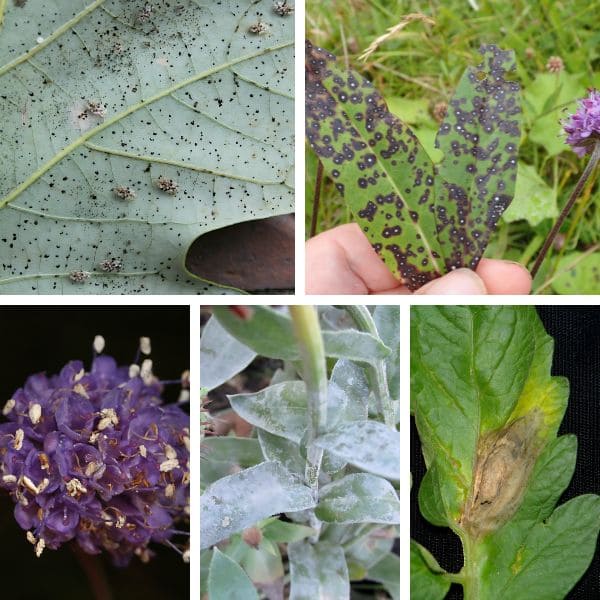
Common Problems
Poor Flowering
Scabiosa may produce fewer blooms if not provided with adequate sunlight. Ensure the plants receive at least six hours of direct sunlight daily for optimal flowering.
Over-fertilization can also inhibit blooming; reduce fertilizer use if blooms are sparse.
Leggy Growth
Leggy growth occurs when plants stretch towards light, often due to insufficient sunlight or overcrowding.
Ensure proper spacing between plants and adequate light exposure to maintain a compact shape.
Won’t Grow Back
Even reliable perennial scabiosa may sometimes not return due to temperature changes or other environmental factors. So, it’s best for you to select hardy varieties.
Harvest
The best time for you to harvest scabiosa flowers is in the morning when temperatures are cooler, and the plants are well-hydrated.
Cut flowers when they are fully open but before they start to decline.
Remember to cut stems to the desired length, typically 12-18 inches, making a clean cut at a 45-degree angle to increase the surface area for water uptake.
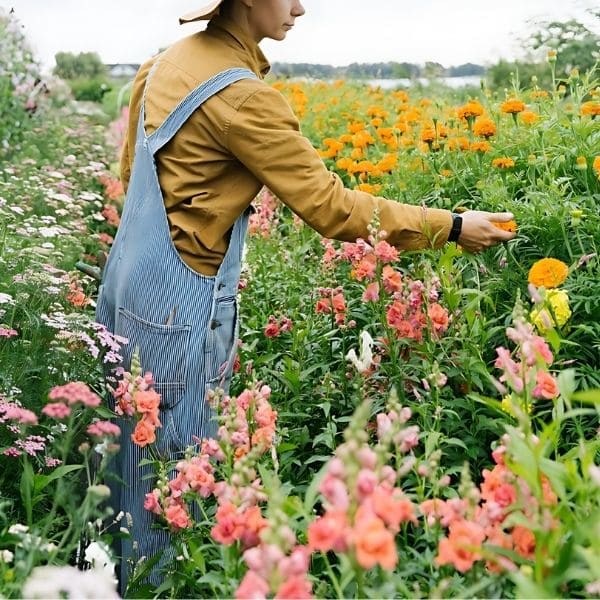
Preservation
Arranging
Firstly, place the cut flowers immediately in a bucket of clean, cool water to keep them hydrated.
Next, strip off any leaves that would be submerged in water to prevent rot and bacterial growth.
Then you can arrange the flowers in vases with fresh water and flower food. Change the water every 2-3 days and recut the stems to keep them fresh.
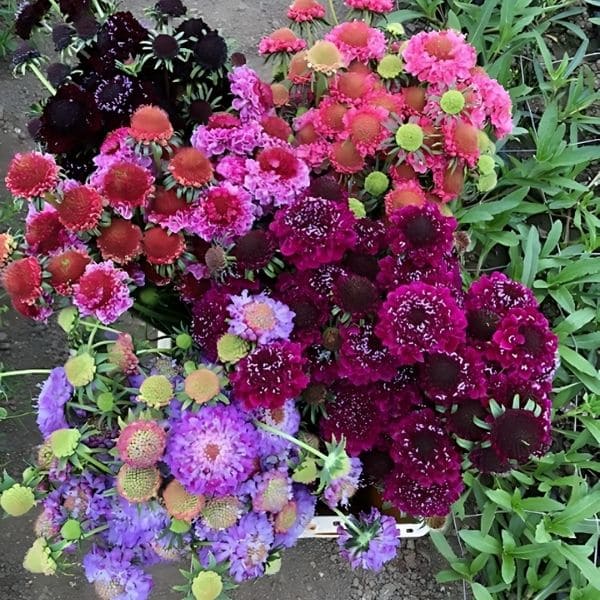
Drying
Hang the flowers upside down in small bunches in a dark, well-ventilated area to dry. You should let the flowers dry completely in 1-2 weeks.

FAQs
Can Scabiosa be grown in pots?
Yes, compact varieties like Scabiosa ‘Butterfly Blue’ thrive in containers with well-draining potting mix and regular care.
How long does Scabiosa last?
Scabiosa is a perennial plant that can last for several years with proper care and maintenance.
How long does it take for Scabiosa to bloom?
Scabiosa typically blooms within 8-12 weeks after planting from seeds, depending on growing conditions and variety.
Will Scabiosa self-seed?
Yes, Scabiosa can self-seed under favorable conditions, producing new plants in the garden.
How do you get rid of Scabiosa?
To remove Scabiosa plants, dig up the root system or cut back plants and apply an herbicide, following manufacturer instructions.
Is Scabiosa a filler flower?
Yes, Scabiosa is often used as a filler flower in floral arrangements due to its delicate blooms and long vase life.
